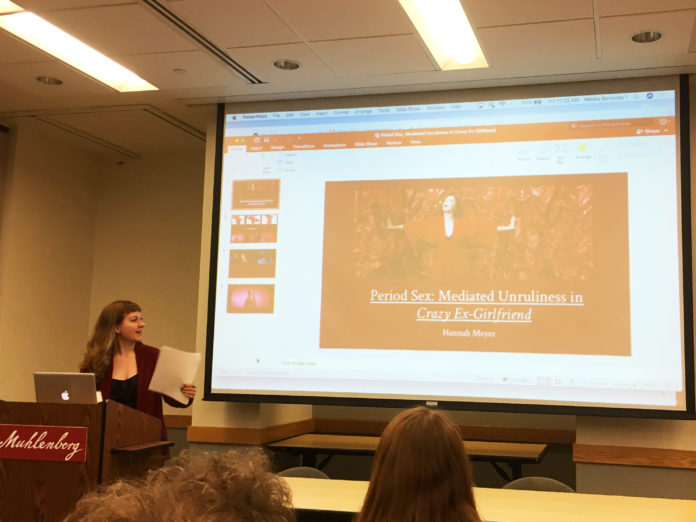
On Friday, Apr. 12 And Saturday, Apr. 13, students and faculty from across the globe gathered in Seegers Union to hear an array of student research presentations as part of the Society for Cinema and Media Studies Undergraduate Conference, or SCMSU.
Dr. Elizabeth Nathanson, Associate Professor of Media & Communication, and Dr. Amy Corbin, Associate Professor of Media & Communication and Film Studies, were the co-chairs of this event, due to their previous affiliation with the main organization, The Society for Cinema and Media Studies. Nathanson has been attending this conference since 2006.
“I have presented at the main conference,” notes Nathanson. “The main conference has become a really important space for me, as a scholar, to present work and connect with a larger scholarly community.”
With a goal of allowing students to also engage in this networking and scholarly opportunity, Nathanson and Corbin contacted the main organization, and planned on hosting the conference here next year. Around Thanksgiving time, however, they were informed that the previous institution that was supposed to host the conference dropped out, so it would now be here at Muhlenberg even sooner than they expected.
After receiving over 100 applications with a limited amount of space, the final conference ended up consisting of just over 30 students.
“I was impressed and surprised and thrilled to see how wide ranging the institutions were that were represented,” says Nathanson. “We had a student from Hong Kong, Canada, and a bunch from California.”
In addition to the diverse and international range of students, there were also two Muhlenberg students: Hannah Meyer ‘19 and Elizabeth Cugnini ‘19.
Cugnini and Meyer each presented during one of the nine sessions that took place throughout the weekend. Meyer presented her paper, “Period Sex: Mediated Unrulines in Crazy Ex-Girlfriend” during the “‘Crazy,’ ‘Monstrous,’ and Disruptive Femininity’” session on Friday. Dr. Nathanson encouraged her to apply after writing this paper for the Feminist Media Studies course.
“I knew that I wanted to write about Rachel Bloom’s show, Crazy Ex-Girlfriend, because it pushes the boundaries of feminist satire,” says Meyer. “I was particularly drawn to the song “Period Sex” because it was banned from appearing on the show directly and was posted on Rachel Bloom’s YouTube channel. I’m interested in the power that comedy has in revealing and satirizing gendered and society conventions, as well as the limits that networks like the CW place upon the limits of satire.”
In addition to her experience at the conference, Meyer also sees the value that this experience could potentially bring her in the future.
“Conferences and academia in general are both micro-utopias. The politics of humor has been something that I’ve been interested in for a long term and is something that I would certainly consider pursuing in grad school,” Meyer notes.
Cugnini’s paper, “Distortions of Time in and Around the Cult Film Wet Hot American Summer, was during the “Queer and Trans Realities and Mediated World-building” session also on Friday.
“I am in the Media Communications Honors Seminar and Dr. Chien, the director of it, recommended the conference to me,” explains Cugnini. “I am working on this paper for class so I thought it was a perfect fit. To present about queer temporalities in film for a cinema and media studies conference worked perfectly. I am fascinated by cult films and what makes these films so special. So I started researching cult films I enjoy and Wet Hot American Summer was one of them. I love this film and I wanted to look into what makes it so special.”
For students hoping to get involved in conferences like this in the future, Nathanson recommends local conferences, such as the Media Research Social Justice Undergraduate Conference, or other ways of collaborating and researching with faculty through research grants or independent studies.
“The whole experience was deeply rewarding,” says Nathanson, reflecting on this conference. “Seeing students from all over the place connecting around ideas, and connecting around a real desire to be critical of the media texts that surround us, and appreciate those texts. Seeing people who have never known each other have a few days of conversation purely from their own sense of curiosity was inspiring.”
Sydney Coplin is a senior majoring in Media and Communication. She is currently spending her final semester of college interning and studying in Washington, D.C. She has previously been on staff as News Editor and Managing Editor.





















